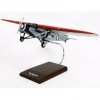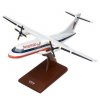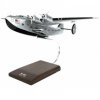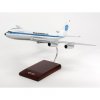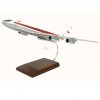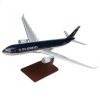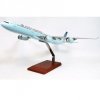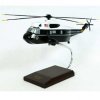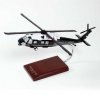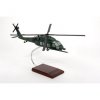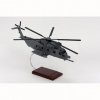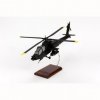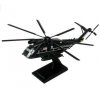"The Boeing 727 is a mid-size, narrow-body, three-engine, T-tailed commercial jet airliner. The 727's fuselage has an outer diameter of 148 inches (3.8 m).[1] This allows six-abreast seating (three per side) and a single central access walkway when coach-class (18 inch width) seats are installed. The first Boeing 727 flew in 1963 and for over a decade it was the most produced commercial jet airliner in the world. A total of 1,831 727s were delivered. The 727's sales record for the most jet airliners ever sold was broken in the early 1990s by its younger stablemate, the Boeing 737. In August 2008, there were a total of 81 Boeing 727-100 aircraft and 419 727-200 aircraft in airline service"
Scale: 1/100 scale model
Wing Span: 12.75
Length: 18
KB727TWAT
|
"B737-900 Boeing's Next Generation 737-800 and 737-900 are the largest members of the strong selling 737 family. Alaska Airlines launched the B737-900 in 1997 and accepted delivery in 2000. Because the -900 retains the same exit configuration of the -800, seating capacity is limited to 177 seats in two classes, or 189 in a single-class layout. The 737-900 also retains the MTOW and fuel capacity of the -800, trading range for payload. The B737-900 is the newest addition and the largest variant of the Boeing 737 line and was introduced to meet the range and passenger capacity of the discontinued 757-200 and to directly compete with the Airbus A321. An additional pair of exit doors and a flat rear pressure bulkhead increase seating capacity to 180 passengers in a 2-class configuration or 215 passengers in a single-class layout. Additional fuel capacity and standard winglets improve range to that of other 737NG variants. The first B737-900 was rolled out of the Renton, Washington factory on August 8, 2006 for its launch customer, Lion Air. Then on April 27, 2007, Boeing delivered the first B737-900 to Lion Air. The B737-900 airplane features a special dual paint scheme that combines the Lion Air lion on the vertical stabilizer and the Boeing livery colors on the fuselage. Lion Air has ordered 100 737-900ERs to be delivered by 2013. "
Scale: 1/100 scale model
Wing Span: 13.75
Length: 16.75
KB7371ATR
|
"The Boeing 727 is a mid-size, narrow-body, three-engine commercial jet airliner. It first flew in 1963 and for over a decade, Boeing 727 was considered the most produced commercial jet airliner in the world. 1,831 Boeing 727s were delivered. The Boeing 727's sales record for the most jets bought in history was broken in the early 1990s by the Boeing 737. In August 2006, a total of 127 Boeing 727-100 aircraft and 493 Boeing 727-200 aircraft were in airline service. The Boeing 727-200 is a stretched version of the 727-100. The -200 is 20 feet longer (153 feet, 2 inches) than the -100 (133 feet, 2 inches). A ten foot ""plug"" was added in front of the wings and another ten foot ""plug"" was added behind them. The wing span and height remain the same on both the -100 and -200 (108 feet and 34 feet, respectively). The gross weight was increased from 169,000 to 209,500 pounds. The dorsal intake of the number 2 engine was also redesigned to be round in shape, as opposed to oval as it was on the 100 series. At the turn of the 21st century, the 727 was still in service with a few airline fleets. However, because in the meantime the U.S. FAA and the ICAO had changed their requirements for overwater operations, most major airlines had already begun to switch to twinjets, aircraft with only two engines, which are more fuel-efficient and quieter than the notoriously loud three-engined 727. Also, the 727 was one of the last airliners in service to have a three-person flight crew, including a flight engineer, a crewmember whose job is performed by computerized systems on newer planes. The Boeing 727 proved very successful with airlines worldwide partly because of its capability to use smaller runways while still flying medium range routes. Thus, Boeing 727 effectively allowed airlines to attract passengers from cities with large populations but smaller airports to worldwide tourist destinations."
Scale: 1/100 scale model
Wing Span: 12.75
Length: 18
KB727AATR
|
"The Boeing 727 was, for a very long time, the most popular jet-liner in the world. The 727 first took to the skies during the 1960s, much earlier than its bigger and more famous sister the Boeing 747. Through its exceptional fuel efficiency it can fly both long- and short-range routes. The 727-200 is a stretched version of the 727-100. 727-200's maiden flight was on July 27, 1967 and was granted certification in November that year. The 727-200 entered service with the Northeast Airlines, (an airline that was later acquired by Delta) the following month. The 727-200 boosted in sales but it has quite a poor range, so Boeing developed the increased range Advanced 727-200. The 727-200 remains popular with passengers and pilots"
Scale: 1/100 scale model
Wing Span: 12.75
Length: 18
KB727CATR
|
"The Ford Tri-motor was a rugged, dependable transport airplane, which won a permanent place in aviation history. It underwent several design changes. They were flown by more than one hundred airlines in the United States and all over the world. First flew on June 11, 1926. The two main production versions of the Ford Trimotor the 4-AT and the 5-AT was introduced in 1928. The 5-AT-C, which is essentially in original condition, was built in 1929. The Ford Trimotor was dubbed as the Tin Goose and it also appeared in a variety of official and unofficial modifications. It was operated with wheel, float or ski landing gear and had served with all branches of the US military. The Ford 5-AT-C was still operating in the Scenic Airlines of Las Vegas in the 1990s."
Scale: 1/48 scale model
Wing Span: 18
Length: 18
KAT5CAAT
|
"The ATR-42 is a twin-turboprop airliner manufactured by ATR. The ATR42's maiden flight was on August 16, 1984 and it received certification following in September 1985. As of January 2007, there are 390 ATR 42s delivered worldwide, following another 11 aircraft order. There are three major variants of the ATR-42 and an STC exists to convert all ATR 42 variants to all-cargo transport aircraft. Major operators of the ATR-42 are FedEx, UPS and DHL. The ATR-42 ""Surveyor"" is a maritime patrol version of the -500 and VIP transport and in-flight inspection versions of the -500 also exist. The ATR-42 has a seating capacity of 44-50 passengers. It has a cruising speed speed of 556 km/h and a range of 2,965 km. t incorporates Pratt & Whitney Canada PW127E. The rear door is used to avoid possible injuries from the blades of the spinning propellers and the vast majority of commercial aircraft are boarded from the front. The ATR-42 also doesn't have Auxiliary Power Unit (APU), but it has a propeller brake, allowing the turbine to run and provide air power to the aircraft without the propeller spinning. Thus it eliminates the need for added weight and expense of an APU. the engines are periodically switched during maintenance to ensure equal wear. "
Scale: 1/48 scale model
Wing Span: 20
Length: 19
KATR42AET
|
"The revolutionary Boeing 247, developed in 1933, was an all-metal, twin engine airplane and the first modern passenger airliner. It had a gyro panel for instrument flying, an autopilot, pneumatically operated de-icing equipment, a variable-pitch propeller and retractable landing gear. It also featured thick upholstered chairs, an insulated cabin, a lavatory and individual overhead lighting. The phenomenon of the Model 247 caught the attention of America's young airline companies. When its commitment to United prevented Boeing from filling orders fast enough, Transcontinental and Western Air (TWA) turned to Douglas. Douglas offered to build something similar to the Boeing 247, only faster and larger. TWA quickly accepted the proposal. The Douglas DC-1 which was eventually refined as the legendary DC-3, immediately attracted new customers. Thus, making the 247 obsolete less than a year after its first flight. Seventy-five 247s were built. Boeing Air Transport flew 60 247s. United Aircraft Corporation flew 10 and the rest went to Deutsche Lufthansa and a private owner in China. The Boeing 247s remained in airline service until World War II, when several were converted into C-73 transports and trainers. Some were still flying along with the Douglas DC-2 that supplanted it, the Model 247 ushered in the age of speed, reliability, safety and comfort in air travel."
Scale: 1/48 scale model
Wing Span: 18.5
Length: 12.63
KB247UATE
|
"The Boeing 314 ""Clipper"" is a long-range flying boat produced between 1938 and 1941 by the Boeing Airline Company. It is one of the largest aircraft at that time using the massive wing of earlier XB-15 bomber prototype. The Boeing 314 uses a series of heavy ribs and spars, creating a strong fuselage and cantilevered wing. It incorporates sponsons into the hull structure. The Pan Am Clippers were built for luxury, a necessity given the long duration of transoceanic flights. Pan American World Airways signed a contract for six Boeing 314 on July 21, 1936. The first 314, the Honolulu Clipper, entered service in January 1939. Pacific Clipper was enroute to New Zealand during the outbreak of war in the Pacific. In June 24, 1939, the Yankee Clipper had flown across the Atlantic on a route from Southampton to New York with intermediate stops at Foynes, Ireland, Botwood, Newfoundland and Shediac, New Brunswick. The Boeing 314 Dixie Clipper is another aircraft operated by Pan Am. It started its transatlantic passenger service in 1939 and was later sold to World Airways. It was scrapped on 1950. "
Scale: 1/100 scale model
Wing Span: 18.5
Length: 12.5
KB314T
|
"The Boeing 367-80, or ""Dash 80"" as it was called within Boeing, was a concept jet transport built to demonstrate that high speed jet transport was no longer the sole preserve of military aircraft. Boeing 367-80 was considered to be the prototype for both the Boeing 707 airliner and the C-135 series aircraft (including the best known variant, the KC-135 air tanker used by the United States Air Force), the Boeing 367-80 was built in less than two years from project launch in 1952 to rollout on May 14, 1954 for a cost of US$16 million. This was at the time an enormous risk for the Boeing Company, since they had no committed customers for the project. By early 1952 the designs were complete, and on April 1952, the Boeing board approved the program to build the jet. Construction of the Boeing 367-80 took place at Boeing's Renton, Washington plant, but as a prototype there was no production line and most of the parts were custom built. The plane's interior was not fitted with an airline cabin; rather it consisted of a basic plywood lining that was used to house the test instrumentation required for the flight test program. In addition to the flight testing program, Boeing also used the Boeing 367-80 to provide demonstration flights to airline executives and other key industry figures."
Scale: 1/100 scale model
Wing Span: 15.5
Length: 15.38
KB367T
|
McFarlane SportsPicks is no stranger to recreating some of the NBA’s greatest players as highly detailed action figures and their 20th lineup is no exception.
This Set of NBA Series 20 seven 6-inch tall pieces contains the following players
-1x Carmello Anthony (New York Knickks)
-1x John Wall (Washington Wizards)
-1x Dwyane Wade (Miami Heat)
-1x Kevin Durant (Oklahoma City Thunder)
-1x Kobe Bryant (Los Angeles Lakers)
-1x Derrick Rose (Chicago Bulls)
-1x Blake Griffin (Los Angeles Clippers)
|
"The Boeing 377 Stratocruiser was the civilian version of the C-97 Stratofreighter, which in turn was derived from the B-50 Superfortress. It first flew on July 8, 1947. Despite serious design flaws and a marginal service record, the Stratocruiser was considered one of the greatest post-war propeller airliners. In the 1960s, several Stratocruisers were modified by Aero Spacelines to make oversized transports and were dubbed as ""Guppys"". The Boeing 377 has a seating capacity of up to 100 passengers on main deck and an additional 14 in lower deck lounge. The typical seating for 63 or 84 passengers. It incorporates 4 Pratt & Whitney R-4360-B6 Wasp Major 28-cylinder radial engines four-bladed propellers. It has a maximum speed of 375 mph and a range of 3,650 nm. The primary users and operators of the Boeing 377 are the Pan Am and the BOAC. Extremely complex and expensive, only 56 were built. It continued in mainline service until 1960, when it had been made obsolete by the coming of the 707 and other first generation jetliners. "
Scale: 1/100 scale model
Wing Span: 16.5
Length: 13
KB377NWT
|
"The Boeing 377 Stratocruiser was airliner version of the 367 Boeing Stratofreighter, which in turn was the transport version of B-29 Superfortress. It first flew on July 8, 1947. It was generally considered the greatest airliner in the air before the coming of the 707 and was the flagship of the Pan Am fleet. The Boeing 377 Stratocruiser has a variety of interior configurations which could accommodate 55 to 112 passengers or if equipped as a sleeper, with 28 upper and lower berth units plus five seats. The Boeing 377 Stratocruiser has a maximum speed of 375 mph and a range of 4,200 miles. There's a total 55 Boeing 377 Stratocruisers built. In 1963, B-377s disappeared from service."
Scale: 1/100 scale model
Wing Span: 16.5
Length: 13
KB377T
|
"The Boeing 707 transport marks the real beginning of the revolutionary jet age in transportation. There were over 900 Boeing 707 commercial transports built. By 1980, the 707 was no longer in production as a commercial transport. Today, many people still consider the terms 707 and jet transport to be synonymous. Boeing developed the 707-320 Intercontinental series which is a stretched version of the original 707 model with increased range, making it a true intercontinental jet. Boeing 707-320 was a later version of the Boeing 707 series, which had larger wings, and more fuel capacity to operate as a true, transoceanic aircraft. It also had a large cargo door, making it a dual-purpose transport aircraft. Although the Boeing 707 was not the first commercial jetliner in service, yet it was the first to be commercially successful."
Scale: 1/100 scale model
Wing Span: 17.5
Length: 18.5
KB707AAT
|
The Boeing 707-320 civilian variant of the 707 is a stretched version of the turbojet-powered original model. The 707-320's maiden flight was on January 11, 1958. It incorporates JT4A-3 turbojets which produce 15,800 lbst each. The interior of the 707-320 allows seating for up to 189 passengers. The longer wing could carry more fuel, increasing range by 1,600 miles and allows the it to operate as a transoceanic aircraft. There were 60 turbojet -320s produced.
Wing Span: 17.5
Length: 18.5
KB707PAT
|
The new version of the 707 was the 707-320, featuring an added larger wings and more fuel capacity to allow for transcontinental flights, making it a true intercontinental jet. It incorporates JT4A engines. The improvements of the 707-320 allows increased fuel capacity from 15,000 gallons to more than 23,000 gallons.
Scale: 1/100 scale model
Wing Span: 17.5
Length: 18.5
KB707TWAT
|
"The Airbus A320 is a short-to-medium range commercial passenger airliner manufactured by Airbus SAS. The Airbus Family members include the A318, A319, A320, and A321, as well as the ACJ business jet. Airbus A-320 flew for the first time in February 22, 1987 and first delivered in 1988. The A320 pioneered the use of digital fly-by-wire flight control systems in a commercial aircraft. With more than 3,000 aircraft of the A320 family built, it is the second best selling jet airliner family of all time, after the family's primary competition, the Boeing 737. The A320 Airbus features a computerized on-board maintenance system. The avionics systems are designed for easy upgrade without major rework. With the exception of the very earliest A320's, most can be upgraded to the latest avionics standards, keeping the aircraft advanced even after almost 2 decades in service. Also integral to the A320 is the advanced electronic flight deck; with six fully integrated EFIS colour displays and innovative side stick controllers rather than conventional control columns. The A320 also employs a relatively high percentage of composite materials compared to earlier designs. Two engines are offered, the CFM56 and IAE V2500. The A-320 has seating for 150 to 179 passengers, these accommodated in a wider cabin than most single-aisle aircraft, allowing for far greater comfort and the ability to take standard baggage containers. Typical cruising speed of the Airbus A-320 is Mach 0.8 with a range of 3,270 miles with 150 passengers and luggage. "
Scale: 1/100 scale model
Wing Span: 13.5
Length: 14.75
KA320UATR
|
"The US Airways is an American low-cost airline headquartered in Tempe, Arizona, owned by US Airways Group, Inc. In 1996, the airline ordered up to 400 new Airbus A319, A320 and A321 narrow-body twin jets for delivery starting in 1998 and continuing through 2009; then within days announced its new identity as US Airways. The A320, a short to medium range airliner, is perhaps best known as the first airliner to introduce a fly-by-wire flight control system. The most important contributor to Airbus Industry's success as an airliner manufacturer, the four member A320 family is significant sales success and a technological trailblazer. As of early 2003, firm orders for the A320 stood at 1397 with 1131 delivered. The A320-200 is one of the member of A320's it has a maximum cruising speed of 903km/h at 28,000ft, economical cruising speed of 840km/h at 37,000ft. The A320 Airbus features a computerized on-board maintenance system. The avionics systems are designed for easy upgrade without major rework. With the exception of the very earliest A320's, most can be upgraded to the latest avionics standards, keeping the aircraft advanced even after almost 2 decades in service. The A-320 has seating for 150 to 179 passengers, these accommodated in a wider cabin than most single-aisle aircraft, allowing for far greater comfort and the ability to take standard baggage containers. Typical cruising speed of the Airbus A-320 is Mach 0.8 with a range of 3,270 miles with 150 passengers and luggage."
Scale: 1/100 scale model
Wing Span: 13.5
Length: 14.75
KA320USATR
|
"The A330-300 is the biggest member of Airbus' twinjet family and is closely related to the four engined long range A340 with which it shares near identical systems, airframe, flightdeck and wings, the only major difference being the twin (versus four) engine configuration. The A340 and A330 were launched simultaneously in June 1987. Although developed in parallel the A330-300 made its first flight after the A340, on November 2 1992. It was the first aircraft to achieve simultaneous European Joint Airworthiness Authorities (JAA) and US FAA certification, on October 21 1993. Entry into service took place by the end of that year. Differences from the A340 aside from the number of engines are slight changes to the wing and internal systems, including fuel tankage. The A330 (like the A340) takes advantage of a number of technologies first pioneered on the A320, including the common advanced EFIS flightdeck with side stick controllers and flybywire computerised flight control system. While the standard A330-300 shares the same fuselage length as the A340-300, Airbus has studied various stretched (A330-400) and shortened (A330-100 and 200) versions. The shortened A330-200 was formally launched in 1996 as a long range 767-300ER competitor, and is described separately. One stretched, high capacity concept studied for a time featured lower deck seating in place of the forward freight hold. "
Scale: 1/100 scale model
Wing Span: 23
Length: 24.75
KA330NWTR
|
"The A330-300 is the largest member of the twin-engine A330 series. The Airbus A330-300 was developed as a replacement for the A300. It entered service in 1993. The A330-300 has a seating capacity of 295 passengers in a three class cabin. It is incorporates two Pratt & Whitney PW4000 or Rolls-Royce Trent 700 engines. It has a maximum cruise speed of Mach 0.86 and a range of 5,669 NM. The A330-300 offers the best balance for range and cost. It's highly efficient and optimized for medium-to-extended-range market."
Scale: 1/100 scale model
Wing Span: 23
Length: 24.75
KA330USATR
|
"The A340-500 is the world's longest-range commercial airliner. A340-500's maiden flight was on February 11, 2002 and it received certification on December 3, 2002 and was delivered to Emirates Airline. The A340-500 has a seating capacity of 313 passengers in a three class cabin. The A340-500 features a 4.3 m stretched fuselage, an enlarged wing area, massive increase in fuel capacity, slightly higher cruising speed, larger horizontal stabilizer and smaller vertical tailplane. It also has taxi cameras to help pilots during ground maneuvers. The A340-500 is powered by four 53,000 lb thrust Rolls-Royce Trent 553 turbofans. The A340-500 is capable of traveling non-stop from London to Perth, Australia, though a return flight requires a fuel stop due to headwinds. Thai Airways International also had flown the A340-500 non-stop from Bangkok to Los Angeles and Bangkok to New York. The most recent customer of the A340-400 is the Etihad Airways. Emirates Airline is the largest operator of the A340-400, with 10 aircraft in service. In February 2006, the 777-200LR entered service, replacing the A340-500 as the world's longest-range commercial airliner."
Scale: 1/100 scale model
Wing Span: 23.75
Length: 24.75
KA340ACTR
|
"The Javelin is a small high-speed personal jet being developed by the Aviation Technology Group (ATG). Planned for FAA certification under 14 CFR part 23, the Javelin has a design resembling a fighter aircraft, an unusual concept for civilian jets. The Javelin MK-20 derivative, being developed in cooperation between ATG and Israel Aerospace Industries, is expected to fill the jet trainer role for various air forces. The Javelin is designed to look and perform like a fighter jet. Pre-orders are being sold for approximately US$ 2.995 million in the civil market. ATG is presently headquartered at Centennial Airport (KAPA) in Centennial, Colorado, with manufacturing facilities at Front Range Airport (KFTG) in neighboring Aurora."
Scale: 1/32 scale model
Wing Span: 9.5
Length: 14
KAJT
|
"The Airbus A320 is a short to medium range commercial passenger airliner manufactured by Airbus. The A320 was first delivered in 1988 and it uses digital fly-by-wire flight control systems. At that time, the American West Airlines was experiencing financial troubles due to the rapid growth of the airlines which resulted in large operating losses. During 1986, the company was in the verge of bankruptcy. In 1990, the American West Airlines moved into the new terminal 4 and also took the delivery of several Airbus A320 aircraft that were destined for the now defunct Braniff Airways. The A320s were sold to America West at a steep discount. The America West Airlines continued to lose money and operated in bankruptcy from 1991 to 1994. The company resorted to organizational restructuring and the bankruptcy also forced a number of changes on the management aspect. The American West continued ordering Airbus A320 and gradually started retiring its older Boeing 737-200 aircraft. The most notable contribution of the A320 airliner is that it was the best selling member among the family. The A320 features a computerised on-board maintenance system. It also features a wider single-aisle cabin and larger overhead bins. The A320 airliners and other variants (A318, A319, and A321) incorporate LCD (liquid crystal display) units in the flight deck instead of the original CRT (cathode ray tube) displays. There are over 3,000 A320 airliners built, making it the second best selling jet airliner family of all time. "
Scale: 1/100 scale model
Wing Span: 13.5
Length: 14.75
KA320AWTR
|
"The VH-3D Sea King is a twin-engined, all-weather helicopter in support for the transportation operations of the United States President. It was flown by the Marine Helicopter Squadron One. It was developed from the series of Sikorsky S-61 and it was already in the air more than 40 years. It was built as an anti-submarine sensor carrier for the United States Navy. It is the replacement for the SH-60F Sea Hawk for the role of an antisubmarine warfare helicopter. In December 1974, the helicopter was delivered to HMX-1 to replace the VH-3A. It entered the service in 1963. The VH-3A helicopter was entirely replaced by the VH-3D in 1976. The United States Army Executive Flight Detachment was activated in January 1 1958. Together with the Marine Helicopter Squadron One they were given a task to evacuate the President, his family and other government officials. The VH-34D was the primary executive transport helicopter but it was replaced by the VH-3D Sea King in 1961. It was built for the United States Navy as a carrier based anti-submarine helicopter with modified interiors. It was the preferred VIP and executive transport. John F. Kennedy requested the executive aircraft to bear unique markings. He wanted the choppers to have a white and green paint design on both sides of the fuselage, a flag of the United States on the engine cowling, and the Presidential seal on the nose of the helicopter. The helicopter is still in use. It can be seen on televisions whenever it is being used to transport President George W. Bush. "
Scale: 1/48 scale model
Wing Span: 15.5
Length: 13
HVH3DT
|
"The Presidential Helicopter Replacement (VH-71) was a dual-piloted, multi-engine vertical take-off and landing aircraft that would bring the latest vertical lift and command and control communication technology to the primary helicopter platform employed by HMX-1. The VH-71 would be capable of operating day or night, in adverse weather worldwide, in climates including arctic, desert, mountainous, littoral, and tropical. Marine Helicopter Squadron One (HMX-1) is required to provide safe and timely transportation for the President and Vice President of the United States, heads of state and others as directed by the White House Military Office (WHMO). Currently two Type, Model, Series (TMS) aircraft are used by HMX-1 for the Presidential support mission, the VH-3D and the VH-60N. The VH-71 program provides the replacement helicopter for the VH-3D and VH-60N. The future ""Marine One"" would be one of the world's most technologically advanced helicopters, designed to safely and reliably transport the president, vice president, heads of state and other official parties both at home and abroad with mobile ""oval office in the sky"" capabilities."
Scale: 1/65 scale model
Wing Span: 11.25
Length: 13.75
HVH71T
|
"The Boeing Model 307 Stratoliner was the first fully pressurized airliner to enter service anywhere in the world. Capable of flying 20,000 feet higher than the 5,000 to 10,000-foot altitude unpressurized airplanes at that time, it was said that it could “fly above the weather�. The Model 307 had a capacity for five crew members and 33 passengers, and had a nearly 12-foot wide cabin for overnight berths. It was the first plane to include a flight engineer as a crew member. Only ten Stratoliners were produced. Three were built for Pan Am, five served with TWA, and a ninth was supplied to multi-millionaire Howard Hughes. The prototype crashed during a test flight. By 1940, the Model 307 was flying routes between Los Angeles and New York, as well as to locations in Latin America. Howard Hughes purchased a model for his personal use, and had it transformed into a luxurious “flying penthouse�. This same plane was later sold to oil tycoon Glenn McCarthy in 1949. The only surviving Stratoliner, operated by Pan Am, is preserved in flying condition at the Smithsonian Museum's Steven F. Udvar-Hazy Center. On March 29, 2002, this particular aircraft was subject to a dramatic crash in which it ditched into Elliott Bay in Seattle, Washington, on what was to be its last flight before heading to the Smithsonian. Despite the incident, it has again been restored and is now on display. "
Scale: 1/72 scale model
Wing Span: 18.5
Length: 12.63
K307PAT
|
"The A320 Airbus family is a short to medium range commercial passenger airliner manufactured by Airbus. The A320 series has two variants, the A320-100 and A320-200. The A320-200 is the definitive version and was delivered together with the A320-100 to Air Inter, an airliner acquired by Air France, Air France and British Airways. The A320-200 features wingtip fences and has an increased fuel capacity compared to the A320-100 for an increased range. The A320-200 has 2,900 nautical miles typical range with 150 passengers. It incorporates two CFMI CFM56-5 or IAE V2500 with thrust ratings between 25,500 to 27,000 pounds force. The A320-200 direct Boeing competitor is the 737-800. There are more than 3,000 A320s built and is the second best-selling jet airliner family of all time "
Scale: 1/100 scale model
Wing Span: 13.5
Length: 14.75
KA320ACTR
|
Air France is a Paris-based airline that operates worldwide scheduled passenger and cargo services to 185 destinations in 83 countries. In 1988, it became a launch customer for the A-320 narrowbody twin. The A320 is a short-to-medium range commercial passenger aircraft manufactured by Airbus.
Scale: 1/100 scale model
Wing Span: 13.5
Length: 14.75
KA320AFTR
|
"The UH-1 Huey Iroquois is a multipurpose utility helicopter. It was manufactured by Bell Helicopter Textron. Its maiden flight was on the 22nd of October 1956 but it was introduced commercially in 1959. Its primary users are the United States Army, Japan Ground Self-Defense Force, Royal Australian Air Force, and Philippine Armed Forces. The Huey, as it is commonly known, became famous for its use in the Vietnam War. The “U” stands for Utility as compared to Attack and the Cargo helicopters. In 1959, the Huey was first used by the military and in 1962 it went into triservice production and became the UH-1. The UH-1 has a lot of variants. The United States Military variants are the XH-40 which is the initial Bell 204 prototype; the YH-40 which the sixth pre-production aircraft; the HU-1A which is known initially as the Bell 204 production model but redesignated in 1962 as the UH-1A; the HU-1B which is an upgraded HU-1A having various external and rotor improvements and in 1962 it was redesignated as the UH-1B; the UH-1C which is similar to the UH-1B; the YUH-1d which is a pre-production prototype of the UH-1D; the UH-1D which is initially the Bell 205 production model and the long fuselage version of the Bell 204. "
Scale: 1/32 scale model
Wing Span: 18
Length: 15.75
HUH1DT
|
"Sikorsky, the manufacturer of UH-34, originally developed Seahorse for the Navy but the Army would become a primary user as well using the name “Choctaw”. The U. S. Army employed the UH-34 principally for general utility purposes, as well as VIP transport flights, and SAR missions. The UH-34 played a major role for the Navy in anti-submarine warfare along with search and rescue duties. In the Vietnam War, the Marine Corps depended on Seahorse reliability and modified the UH-34 into one of the first gunship helicopters of the war. The Army's Choctaw helicopter successfully carried out numerous missions in Vietnam ranging from combat assault to medical evacuation and general cargo transportation. The UH-34 was also the final evolution of large piston-engine helicopters before the rise of turbine powered designs. Ultimately the UH-34 was flown by all branches of the U. S. military and also by the armed forces of Argentina, Belgium, Brazil, Cambodia, Canada, Chile, Costa Rica, France, Germany, Haiti, Indonesia, Israel, Italy, Japan, Katanga, Laos, Netherlands, Nicaragua, Philippines, Soviet Union, Thailand, United Kingdom, Uruguay, and Vietnam. The Sikorsky UH-34D variant of the Seahorse, used for assault missions, was a 12-seater military helicopter mainly used by the U.S Navy. The US Marine Corps ordered the HUS-1 Seahorse (UH-34D) version on October 15, 1954. This helicopter entered Marine service on March 31, 1961, and served in units at New River, North Carolina; Jacksonville; Santa Ana and El Toro, California; and New Orleans. On November 25, 1970, it was retired and placed in storage at Davis-Monthan Air Force Base, Arizona, having accumulated 3,416 flying hours. "
Scale: 1/48 scale model
Wing Span: 12.5
Length: 14.25
HUH34DT
|
The UH-60 Black Hawk is the Armys front-line utility helicopter used for air assault, air cavalry, and aeromedical evacuation units. It is designed to carry 11 combat-loaded, air assault troops.
Scale: 1/48 scale model
Wing Span: 13.5
Length: 12
HUH60TR
|
"Developed and built jointly by Bell Helicopter Textron and Boeing Helicopters, the V-22 Osprey is a joint service, multi-mission, military tilt rotor aircraft with both a vertical takeoff and landing (VTOL) and short takeoff and landing capability (STOL). It is designed to perform missions like a conventional helicopter with the long-range, high-speed cruise performance of a turboprop aircraft. The initial operators are the U.S. Marine Corps and United States Air Force. The Federal Aviation Administration (FAA) classifies the Osprey as a model of powered lift aircraft. The V-22 first flew on March 18, 1989. The V-22 Osprey is twice as fast as a helicopter and has much longer range resulting in greater mission versatility than a helicopter. The V-22 Osprey’s multi-mission capability provides: amphibious assault, combat support, long-range special ops infiltration and exfiltration, transport, search and rescue, medevac, and, in the future, tanker capability. The V-22 Osprey aircraft can transport 24 combat troops or up to 20,000 pounds of internal or external cargo using its medium lift and vertical takeoff and landing capabilities. Boeing V-22 meets U.S. Navy requirements for combat search and rescue, fleet logistics support, and special warfare support and matches the U.S. Special Operations Command's requirement for a high-speed, long-range, vertical lift aircraft. It can be stored aboard an aircraft carrier because the rotors can fold and the wing rotate. The Osprey has air-to-air refueling capability, the cornerstone of the ability to self-deploy. "
Scale: 1/48 scale model
Wing Span: 13
Length: 14.5
HV222TR
|
"The V-22 Osprey is a tilt rotor helicopter that was manufactured by Bell Helicopter and Boeing Company. It is an aircraft that takes off just like an ordinary helicopter but flies like a plane. It is an aircraft with great range, speed, and flexibility as it is twice the speed, five times the range, and twice as high as the older aircraft that it replaced. The V-22’s maiden flight was on the 19th of March 1989 and it was introduced commercially on the 8th of December 2005. Its primary users are the US Marine Corps and the US Air Force. The US Marines are the first to make use of the V-22 aircraft. It is said that it can efficiently save lives because it flies higher and faster than any other helicopter during its time. It is said to be the first aircraft designed to meet the needs of all four United States armed services. The United States Marine Corps took the V-22 Osprey to replace the CH-46E and CH-53D assault helicopters. The MV-22 is a medium lift assault aircraft. It can self-deploy and can sustain land operations. It can provide combat assault transport hence it was designated as the baseline variant for the Marines."
Scale: 1/96 scale model
Wing Span: 6.5
Length: 7.25
HV22TR
|
"The Sikorsky SH-60/MH-60 Seahawk (or Sea Hawk) is a twin turbo shaft engine, multi-mission United States Navy helicopter based on the airframe of the United States Army/Air Force UH-60 Black Hawk. The SH-60 Seahawk is still being operated by the U.S. Navy. The SH-60B variant of the Seahawk, a twin-engine helicopter, was the primary anti-submarine platform used by the U.S. Navy. SH-60B was also used for search and rescue, drug interdiction, anti-ship warfare, cargo lift, and special operations. The –B version of the Seahawk first flew on February 11, 1983. The SH-60B, also a Light Airborne Multi-Purpose System (LAMPS Mk III), has a 20deg tractor-type canted tail rotor, a controllable stabilator, conventional fixed landing gear, emergency flotation, an external cargo hook, a rescue hoist, and bomb racks for carrying and launching external stores. In addition, it is equipped with a flight-rated auxiliary power unit, a sonobuoy-launch system, an anti-ice system, a fire-extinguishing system, an environmental control system, an automatic flight control system (AFCS), a single-point pressure refueling system, a helicopter in-flight refueling (HIFR) system, and the necessary avionics and instrumentation for instrument flight and mission accomplishment. The helicopter design is compatible with ships equipped with a recovery, assist, securing and traversing (RAST) system, and the main rotor blades and tail pylon can be folded for storage. In addition, the helicopter can operate on non-RAST equipped combatants and a variety of other naval ships. A total of 260 –B version were built. "
Scale: 1/48 scale model
Wing Span: 13.5
Length: 12
HV60BTR
|
"VH-60 Seahawk Sikorsky is a twin engine multimission maritime helicopter based and developed on the USAF's UH-60 Black Hawk. The VH-60's maiden flight was on 1974 and was introduced in 1979. The VH-60 is able to deploy aboard any air-capable frigate, destroyer, cruiser, fast combat support ship, amphibious assault ship or aircraft carrier, the Seahawk can handle antisubmarine warfare, undersea warfare, naval special warfare insertion, combat search and rescue, vertical replenishment and medical evacuation. Each VH-60 unit costs up to US$36 million. The primary users and operators of VH-60 are the United States Navy, United States Coast Guard and Japan Maritime Self-Defense Force. Currently, VH-60 is still in production and still in active"
Scale: 1/48 scale model
Wing Span: 13.5
Length: 12
HV60TR
|
"HH-60 Jayhawk is a search and rescue (SAR) helicopter based on the airframe of the SH-60 Seahawk manufactured by Sikorsky Aircraft Corporation. The HH-60J Jayhawk is a variant of the HH-60, with a crew of four including a pilot, co-pilot and two flight crew. It has a maximum speed of 180 knots and a range of 700 nautical miles. The HH-60 incorporates two General Electric T700-GE-401C rates at 1980 HpThe HH-60, besides its SAR function, is also used for drug interdiction, cargo lift and special operations. The primary user of the HH-60 Jayhawk is the United States Coast Guard and was developed to replace the aging Sikorsky Pelican in 1986."
Scale: 1/48 scale model
Wing Span: 13.5
Length: 12.5
HH60JTR
|
"In 1980, the United States Coast Guard chose the SA 366 G1 Dauphin to be its short range recovery air rescue helicopter and it was given the title HH-65A Dolphin. A total of 99 Dolphin helicopters were improved for its function as a rescuer for the United States Coast Guard. The aircraft was the replacement of the Sikorsky HH-52A Sea Guard. In 2002, a total of 94 Dolphin units were used by the United States Coast Guard. Some of its functions were for security patrols, pollution control, enforcement of laws and treaties and missions like search and rescue. It is famous for its autopilot abilities that allow the crew to take on other duties. To meet the United States rules in local content engineering, modifications were made to the helicopter. Its engine was changed to Allied Signal LTS-101-750B-2 power plants. In 2004, the engine problems still continued and they decided to replace it with Arriel 2C2 units. It became a more competent and secured aircraft. The improved HH-65A Dolphins were chosen as HH-65C Dolphins. The HH-65A cannot execute water landings. It typically takes a crew of four. The HH-65 Dolphin was produced by the Aerospatiale Helicopter Corporation in Texas. The LTS-101 750B-2 turbo shaft engines were built by the Textron Lycoming in Pennsylvania and the electronic systems was built by the Rockwell International in Iowa. "
Scale: 1/32 scale model
Wing Span: 15.75
Length: 15
HH65ADT
|
"The HH-60 Pave Hawk is a highly-modified edition of the Sikorsky UH-60 Black Hawk chopper. The aircraft was first developed by the United Technologies and Sikorsky Aircraft Corporation. The Pave Hawk is a twin-engine medium-lift helicopter operated by Air Combat Command, Pacific Air Forces, Air Education and Training Command, Air National Guard and Air Force Reserve Command. The HH-60 was first seen in action in 1982. The HH-60 features an upgraded communications and navigation suite that includes an integrated inertial navigation, global positioning, Doppler navigation systems, satellite communications, secure voice, and quick communications system. The HH-60 Pave Hawks costs an estimated amount of $15.8 million. All HH-60s have an automated flying control system, night vision goggles lighting and forward looking infrared system that improves night low-level operations. In addition, some Pave Hawks have color weather radar and rotor blade anti-ice system that gives the HH-60 an all-weather capability. The main role of the Sikorsky HH-60 Pave Hawk chopper is to perform day or night combat search and rescue (CSAR) operations into irreconcilable territories to recuperate downed aircrew and other isolated air force personnel’s during war. The HH-60 may also perform peace-time operations because of its versatility. "
Scale: 1/40 scale model
Wing Span: 16.25
Length: 18.38
HHMH60T
|
"The MH-53J Pave Low III heavy-lift helicopter is the largest, most powerful and technologically advanced transport helicopter in the US Air Force inventory. Under the Pave Low III program, the Air Force modified nine MH-53Hs and 32 HH-53s for night and adverse weather operations. Modifications included forward-looking infrared, inertial navigation system, global positioning system, Doppler naigations systems, APQ-158 terrain-following and terrain-avoidance radar, an onboard-mission computer, enhanced navigation system and integrated avionics to enable precise navigation to and from target areas. The Air Force designated these modified versions as MH-53Js. The MH-53J Pave Lows main mission is to drop off, supply and pick up special forces who are behind enemy lines. It also can engage in combat search and rescue missions. Low-level penetration is made possible by state-of-the-art terrain following radar, as well as infrared sensors that allow the helicopter to operate in bad weather. The MH-53Js were used in variety of missions during Desert Storm. Pave Lows were also used extensively during Operation Just Cause in Panama. The MH-53M Pave Low IV is a MH-53J model that has been modified with the Interactive Defensive Avionics System/Multi-Mission Advanced Tactical terminal or IDAS/MATT. "
Scale: 1/48 scale model
Wing Span: 19.2
Length: 21
HMH53JT
|
"The RAH-66 Comanche is an advanced U.S. Army military helicopter for reconnaissance, incorporating stealth techniques. The US Army planned to purchase almost 1,300 Commanches for scout and light attack roles and in May 1995, the first of the prototypes rolled out of the Sikorsky Aircraft Corporation's helicopter production facility. The prototypes maiden flight was on January 4, 1996. The RAH-66's very sophisticated design and navigation systems, allowing it to operate at night and in bad weather. Its airframe was designed to fit more easily than the Apache into transport aircraft or into transport ships, enabling it to be deployed to hot spots quickly. The RAH-66A has a crew of 2. It has a maximum speed of 175 knots and a range of 262 nmi. The primary user of the RAH-66 Comanche was the United States Army. On February 23, 2004, the US Army cancelled the Comanche helicopter program to provide funds to renvation with existing helicopter fleet of aging attack, utility and reconnaissance aircraft. Other factor was the growing popularity of Unmanned Aerial Vehicles for reconnaissance purposes and UAVs had proven their worth in Afghanistan and Iraq. Technology incorporated to the Comanche will be integrated into the Apache and other US military helicopter developments and some its roles will be taken over by the Bell ARH-70. "
Scale: 1/48 scale model
Wing Span: 11.5
Length: 9.75
HR66TR
|
"The AH-1 SuperCobra is a twin-engine attack helicopter based on AH-1 Cobra. The AH-1 Cobra was developed in the mid-1960s as an interim gunship for the U.S. Army. The Cobras and Sea Cobras were deployed in the Gulf War for a support role. The AH-1W Super Cobras destroyed 97 tanks, 104 armored personal carriers and vehiclesand two anti-aircraft artillery sites during the 100-hour ground campaign. The AH-1 was also used by the Pakistan Army as its primary gunship helicopter during the mid- 1970s tribal uprising in Pakistan's Baluchistan province. The AH-1s continued to operate with the U.S. Marine Corps. The AH-1W utilizes a more diverse array of ordnance compared to the Apache. The AH-1W has a crew of 2, one pilot and a co-pilot/gunner (CPG). It has a maximum speed of 190 knots and a range of 317 nm. The primary users of the AH-1 are the U.S. Marine Corps, Islamic Republic of Iran Army, Republic of China Army and the Turkish Army. The AH-1W Super Cobra was considered the backbone of the United States Marine Corp's attack fleet, but it will be replaced by the AH-1Z Viper upgrade in the next decade. "
Scale: 1/32 scale model
Wing Span: 18
Length: 17
HSCT
|
The UH-1C represents the third generation of Bell's iroquois series. Of all Bell's UH-1C machines, this was the most heavily armed. It carried an M-5 40mm grenade launcher on its nose and the M3 Rocket System. Each of the two M3 rocket pods carried twenty-four 2.75 inch rockets and the M-5 grenade launcher held over 300 antipersonnel grenades. Used extensively as escort for unarmed transport helicopters, the Heavy Hog was able to provide especially effective cover and offensive firepower during unloading and recovery operations. The UH-1C saw its combat tour through to the close of the vietnam Conflict, deadly to the enemy and essential to U.S. forces in its capacity as a most formidable gunship.
Scale: 1/48 scale model
Wing Span: 36
Length: 15.5
HUH1C
|
"On November 1967, the HH-3F Pelican helicopter was acquired by the Coast Guard for the purpose of extending its offshore helicopter coverage to 300 miles. The HH-3F is developed for search and rescue, marine environmental protection, logistic and reconnaissance support, enforcement of laws and treaties, defense readiness and drug interdiction. The HH-3F Pelican can accommodate 17 passengers and its side hoist can lift 600 pounds. The significant features of HH-3F are as follows: suspension hoist, hydraulically operated eight foot ramp, computerized navigation system, weather search color radar and automatic flight control system. The HH-3F set the standards for helicopters. Thus the medium range, twin engine amphibian carried sophisticated rotary wings avionics package, cruised at 120 knots and competent of reaching 142 knots. The usual crewmembers of a HH-3F are the pilot, the co pilot, the navigator, the flight mechanic and the passengers. The HH-3F Pelican is also known as the Sikorsky S-61R. It was built under Augusta License as the AS-61R. The HH-3F Pelican served the United States Coast Guard. The US Coast Guard ordered the HH-3F for all weather water rescues. It has a water landing ability which made it a dependable workhorse from the late 1960s. Moreover, the HH-3F Pelican features a search radar with nose antenna random offset to port. "
Scale: 1/48 scale model
Wing Span: 14.5
Length: 15.5
HH3FPT
|
"The Sikorsky HH-53 or the Super Jolly Green Giant was ordered by the USAF for Search and Rescue operations. The Sikorsky HH-53 is the USAF version of the CH-53 Sea Stallion helicopter. The main reason for the development of Sikorsky HH-53 is to replace the HH-3 which is also called the Jolly Green Giant. Later on, the Sikorsky HH-53 was upgraded to MH-53. A lot of Sikorsky HH-53 variants were produced, such as the HH-53B which has a retractable in-flight refueling probe on the right side of the nose, the HH-53C which was an interim type that dispenses with the fuel tank bracing struts, the MH-53H which retained the in-flight refueling probe, external fuel tanks, rescue hoist and three gun armament, the MH-53J which is the largest and most powerful Sikorsky HH-53 variant produced by the US Air Force and the MH-53M has been modified with the Interactive Defensive Avionics System. On March 15, 1967, the Sikorsky HH-53 Super Jolly Green Giant made its first flight at Wright Patterson Air Force Base, Ohio. The Sikorsky HH-53 was faster and had tripled the take off of the HH-3. Other than that, the Sikorsky HH-53 was larger, more heavily armed and with almost double the shaft horsepower. Thus, the Sikorsky HH-53 had better overall performance and hover capability. "
Scale: 1/48 scale model
Wing Span: 18.25
Length: 19.5
HH53DT
|
"The AH-64 Apache is the United States Army's main attack helicopter. It conducts rear, close and shaping missions, as well as distributed operations and precision strikes against relocatable targets. It provides armed reconnaissance when required in day, night, obscured battlefield and adverse weather conditions. It was designed by Hughes Helicopters, which in 1984 was purchased by McDonnell Douglas. In August 1997, McDonnell Douglas merged with Boeing. The AH-64D variant is now being produced by Boeing Integrated Defense Systems. After the cancellation of the AH-56 Cheyenne, the US Army sought an aircraft to fill the anti-armor attack role. It was to be better than the AH-1 Cobra in firepower, performance and range, and have the maneuverability to fly nap-of-the-earth missions. Hence, the Army issued a request for proposals for an advanced attack helicopter in 1972. Five manufacturers submitted proposals, and in 1973 the US Department of Defense selected Bell and Hughes as finalists. Each company built prototypes which underwent a flight test program. After evaluating test results, the Army awarded the contract to Hughes. In late 1981, the AH-64 was given the name “Apache” in keeping with the Army's tradition of using Native American tribal names for its helicopters. In 1983, the first production helicopter was rolled out. The AH-64 entered service in 1984 and was first used in combat during the 1989 US invasion of Panama. The AH-64D Apache Longbow, a more advanced model, began service in 1998. Both the AH-64A Apache and the AH-64D Apache Longbow have played important roles in several Middle Eastern wars, including the Gulf War, Operation Enduring Freedom in Afghanistan, and Operation Iraqi Freedom in Iraq. The Apaches proved to be excellent tank hunters and have destroyed hundreds of armored vehicles, mainly of the Iraqi army. The AH-64D has also been deployed in Afghanistan as part of Operation Anaconda, and from June 2003, in South Korea. Both the AH-64A and AH-64D are still in active service in the US Army. "
Scale: 1/32 scale model
Wing Span: 18.25
Length: 18.25
HA64DLT
|
"The AH-64 is an attack helicopter of the United States Army and the AH-1 Cobra successor. It was manufactured by the Hughes, McDonnell Douglas, and Boeing IDS. Its maiden flight was on the 30th of September 1975 and it is still active in service. Its primary users are the United States Army, Israel Air Force, Japan Ground Self-Defense Force, and Royal Netherlands Air Force. This helicopter was produced in 1984 up to the present time. The Apache is a two-seat principal attack helicopter with two General Electric T700 turboshaft engines. It carries a mixture of AGM-114 Hellfire and Hydra 70 rockets mounted on its stub wing pylons. It is also armed of 30 mm M230 chain gun. It is built to operate day or night and even in bad weather with the use of avionics and electronics like Target Acquisition and Designation System to endure the front line environment. In 1989, the Apache was used the first time in combat through the invasion of Panama, known as the Operation Just Cause. Two of its variants, the AH-64A and the AH-64D, have the most important role in some of the wars in the Middle East such as the Gulf War, the Operation Enduring Freedom in Afghanistan, and the Operational Iraqi Freedom in Iraq. These two variants are serving the United States Army. They are the major models of the AH-64. "
Scale: 1/32 scale model
Wing Span: 18.25
Length: 18.25
HA64LT
|
"During 1960, the United States Marine Corps (USMC) developed a need for a medium-lift tandem rotor assault helicopter that would replace the aging piston engine types being used at that time. Boeing Vertol won the design competition and in 1961 the USMC picked up the CH-46 Sea Knight. Since its introduction, the helicopter has served with both the USMC and United States Navy (USN) faithfully. It has been used in all Marine combat and peacetime environments. Sometimes known as the “Phrog”, the Sea Knight is a descendant of Boeing's first turbine-powered helicopter, the Boeing 107. It is used by the USMC to provide all-weather, day-or-night, night vision goggle assault transport of combat troops, supplies and equipment into or within a battle area. Other tasks include combat support, search and rescue, support for forward refueling and rearming points, casualty evacuation and tactical recovery of aircraft and personnel. The unique tandem rotor design of the CH-46 helicopter allows for increased agility and superior handling qualities in strong relative winds from all directions. Because of this feature, tons of cargo and thousands of passengers have safely been transferred over the years. The Sea Knight can stay airborne for 2-3 hours. It has the ability to land and taxi in the water when needed, and stay afloat for up to two hours in light seas. While other helicopters are extremely limited in various flight maneuvers, the Sea Knight can fly rearward or sidewards. "
Scale: 1/32 scale model
Wing Span: 19
Length: 17
HC46
|
"The CH-53E Super Stallion is the biggest helicopter in the military of the United States. It was built by Sikorsky Aircraft and it is intended for shipping of equipments, goods and personnel in some operations. It is capable in all kinds of weather conditions both day and night. The sailors usually called the CH-53E the “Hurricane Maker” because of the downward force that the helicopter produces. The helicopter can take 37 passengers in its normal design and when it is installed with a centerline seats it can take 55 passengers. The CH-53E is a twin-engined helicopter and can lift 14.5 metric tons of weight. Modifications were made in the helicopter like its defensive electronic countermeasures and its extended fuel tanks. The Navy and Marines was served by the Super Stallion in the role of heavy lift transportation function. A total of 100 CH-53E Super Stallion helicopters are in with the Marines for service. For the US Navy, there are 15 MH-53E helicopters. Some MH-53E helicopters were exported to Japan to be part of the Japan Marines. The usual crew of the Super Stallion is 5. It accommodates two pilots, one right gunner, one left gunner and one tail gunner. Its weight when empty is 33,226 pounds and its maximum weight is 73,500 pounds. It can reach a maximum speed of 196 miles per hour. It is equipped with XM-218 machine guns and GAU-21 with M3M mounted machine gun. Other equipments are chaff and flare dispensers. "
Scale: 1/48 scale model
Wing Span: 19.5
Length: 18.25
HCH53T
|
This handcrafted Tornado 1/48 scale model is painstakingly built by our skilled craftsmen with a wealth of detail. The Panavia Tornado is a family of twin-engine, variable-sweep wing combat aircraft. There are three primary variants of the Tornado; the Tornado IDS (interdictor/strike) fighter-bomber, the suppression of enemy air defenses Tornado ECR (electronic combat/reconnaissance) and the Tornado ADV (air defence variant) interceptor. The Tornados of various operators were used in conflicts in the former Yugoslavia during the Bosnian War and Kosovo War, Iraq during the Gulf War and the Iraq War, Libya during the Libyan civil war, as well as smaller roles in Afghanistan and Yemen. Including all variants, a total of 992 aircraft were built.
This specific Tornado is painted in the German Luftwaffe paint scheme. Deliveries of production Luftwaffe Tornados began in July 1979, and overall they have received a total of 247 Tornados, including 35 ECR variants.
This handcrafted model is painstakingly built from Philippine mahogany by our skilled craftsmen with a wealth of detail and makes a great gift for any veteran, aviation enthusiast or history buff.
Scale: 1/48 scale model
Wing Span: 12.13
Length: 15
FGLTTE
|
This handcrafted Messerschmitt Me-109E 1/24 scale model is painstakingly built by our skilled craftsmen with a wealth of detail. The Messerschmitt Me-109, was a German World War II fighter aircraft. It was one of the first truly modern fighters of the era. The Me-109 first saw operational service during the Spanish Civil War and was still in service at the end of World War II, during which time it was the backbone of the Luftwaffe's fighter force.
This specific Me-109 is the E, which was the first major redesign of the series. The Me-109E, or "Emil", introduced a number of structural changes in order to accommodate the heavier, but significantly more powerful engine, heavier armament and increased fuel capacity. The 109E first saw service with the "Condor Legion" during the last phase of the Spanish Civil War and was the main variant from the beginning of World War II until mid-1941 when the 109F replaced it in the pure fighter role.
This handcrafted model is painstakingly built from Philippine mahogany by our skilled craftsmen with a wealth of detail and makes a great gift for any veteran, aviation enthusiast or history buff.
Scale: 1/24 scale model
Wing Span: 16.25
Length: 14.38
FGM109TE
|
This handcrafted Messerschmitt Bf-110 1/32 scale model is painstakingly built by our skilled craftsmen with a wealth of detail. The Messerschmitt Bf-110, or Me-110, was a twin-engine heavy fighter in the service of the Luftwaffe during World War II. The Bf 110 served with success in the early campaigns, the Polish, Norwegian and Battle of France. However, it's primary weakness was its lack of agility; this flaw was exposed during the Battle of Britain. They were then redeployed as night fighters, a role to which the aircraft was well suited. Later in the war, it was developed into a formidable night fighter, becoming the major night-fighting aircraft of the Luftwaffe. Most of the German night fighter aces flew the Bf 110 at some point during their combat careers, and the top night fighter ace of all time, Major Heinz-Wolfgang Schnaufer, flew it exclusively and claimed 121 victories in 164 combat missions.
This handcrafted model is painstakingly built from Philippine mahogany by our skilled craftsmen with a wealth of detail and makes a great gift for any veteran, aviation enthusiast or history buff.
Scale: 1/32 scale model
Wing Span: 16.25
Length: 14.25
FGM110TE
|
This handcrafted V-2 rocket 1/32 scale model is painstakingly built by our skilled craftsmen with a wealth of detail. The V-2 rocket was a ballistic missile that was developed at the beginning of World War II in Germany. Beginning in September 1944, over 3000 V-2s were launched as military rockets by the German Wehrmacht against Allied targets during the war, mostly London and later Antwerp. The liquid-propellant rocket was the world's first long-range combat-ballistic missile and first known human artifact to enter outer space. It was the progenitor of all modern rockets, including those used by the United States and Soviet Union's space programs. During the aftermath of World War II the American, Soviet and British governments all gained access to the V-2's technical designs and the actual German scientists responsible for creating the rockets.
This handcrafted model is painstakingly built from Philippine mahogany by our skilled craftsmen with a wealth of detail and makes a great gift for any veteran, aviation enthusiast or history buff.
Scale: 1/32 scale model
Wing Span: 17.25
Length: 4
FGV2TE
|
This handcrafted V-1 Flying Bomb 1/20 scale model is painstakingly built by our skilled craftsmen with a wealth of detail. The V-1 Flying Bomb, also known as the Buzz Bomb or Doodlebug, was an early pulse-jet-powered predecessor of the cruise missile. The V-1 was developed by the German Luftwaffe during World War II. At its peak, more than 100 V-1s were fired daily at southeast England, numbers decreased as sites were overrun until October 1944, when the last V-1 site in range of Britain was overrun by Allied forces.
This handcrafted model is painstakingly built from Philippine mahogany by our skilled craftsmen with a wealth of detail and makes a great gift for any veteran, aviation enthusiast or history buff.
Scale: 1/20 scale model
Wing Span: 15.63
Length: 12.38
FGVITE
|
This handcrafted Mitsubishi G4M3 1/48 scale model is painstakingly built by our skilled craftsmen with a wealth of detail. The Mitsubishi G4M was the main twin-engine, land-based bomber used by the Imperial Japanese Navy Air Service in World War II. The Allies gave the G4M the reporting name Betty. The Allies usually gave Japanese fighters and floatplanes male names, while giving female names to bombers and reconnaissance aircraft. The G4M was designed for a long range and high speed at the time of its introduction. Several weight-saving measures were incorporated into the design, such as dispensing with self-sealing fuel tanks, which started nicknames such as "the one-shot lighter", "the flying Zippo" and "the flying cigar" because of their tendency to explode or catch on fire from any slight damage to the fuel tank wings after being hit by aerial machine gun fire or ground antiaircraft fire. The G4M was used for low-altitude torpedo attacks on shipping in which their performance advantages were negated, and the G4M was frequently shot down by antiaircraft artillery fire, and even by small arms. The G4M's relatively large size made it an easy gunnery target, and the predictable approach path required for a torpedo run made for a generally easy interception by Allied fighter aircraft. Towards the end of World War II, the "Betty" bomber was commonly used for carrying and launching kamikaze aircraft, and was the usual aircraft for carrying the Ohka kamikaze manned rocket-powered bombs.
This specific G4M is a G4M3, which is a redesigned G4M2 with added self-sealing fuel tanks, improved armor protection, redesigned wings and an entirely new tail gunner's compartment. The G4M3 entered production in October 1944.
This handcrafted model is painstakingly built from Philippine mahogany by our skilled craftsmen with a wealth of detail and makes a great gift for any veteran, aviation enthusiast or history buff.
Scale: 1/48 scale model
Wing Span: 20.5
Length: 16.5
FJBTE
|
This handcrafted MiG-29 1/48 scale model is painstakingly built by our skilled craftsmen with a wealth of detail. The MiG-29, NATO name "Fulcrum", is a fourth-generation jet fighter aircraft designed in the Soviet Union for an air superiority role. It was developed at the height of the Cold War to counter new American fighters such as the McDonnell Douglas F-15 Eagle, and the General Dynamics F-16 Fighting Falcon. A Soviet response was necessary to avoid the possibility of a new American fighter gaining a serious technological advantage over existing Soviet fighters. The Soviet Union exported MiG-29s to several countries. Because 4th-generation fighter jets require the pilots to have extensive training, air-defense infrastructure, and constant maintenance and upgrades, MiG-29s have had mixed operational history with different air forces. The MiG-29 still remains in use today by the Russian Air Force and many other nations.
This handcrafted model is painstakingly built from Philippine mahogany by our skilled craftsmen with a wealth of detail and makes a great gift for any veteran, aviation enthusiast or history buff.
Scale: 1/48 scale model
Wing Span: 14.75
Length: 10.13
FRM29T
|
This handcrafted Su-27 "Flanker" 1/48 scale model is painstakingly built by our skilled craftsmen with a wealth of detail. The Su-27, NATO reporting name: Flanker, is a twin-engine supermanoeuverable fighter aircraft designed by Sukhoi. The Su-27 most often flies air superiority missions, but is able to perform almost all combat operations. The Su-27's basic design is aerodynamically similar to the MiG-29, but it is substantially larger. It is a very large aircraft, and to minimize its weight its structure has a high percentage of titanium (about 30%, more than any of its contemporaries). The Su-27 began to enter operational service around 1984, although manufacturing difficulties kept it from appearing in strength until 1986.
This handcrafted model is painstakingly built from Philippine mahogany by our skilled craftsmen with a wealth of detail and makes a great gift for any veteran, aviation enthusiast or history buff.
Scale: 1/48 scale model
Wing Span: 11.75
Length: 12
FRSU27T
|
This handcrafted Junkers Ju-88 1/36 scale model is painstakingly built by our skilled craftsmen with a wealth of detail. The Junkers Ju-88 was a World War II German Luftwaffe twin-engine, multi-role aircraft. Affectionately known as "The Maid of all Work" (a feminine version of "jack of all trades"), the Ju-88 proved to be suited to almost any role. Like a number of other Luftwaffe bombers, it was used successfully as a bomber, dive bomber, night fighter, torpedo bomber, reconnaissance aircraft, heavy fighter, and even as a flying bomb during the closing stages of conflict. The assembly line ran constantly from 1936 to 1945, and more than 16,000 Ju-88s were built in dozens of variants, more than any other twin-engine German aircraft of the period. Throughout the production, the basic structure of the aircraft remained unchanged, proof of the outstanding quality of the original design.
This handcrafted model is painstakingly built from Philippine mahogany by our skilled craftsmen with a wealth of detail and makes a great gift for any veteran, aviation enthusiast or history buff.
Scale: 1/36 scale model
Wing Span: 22
Length: 16
FGJ88TE
|
McFarlane SportsPicks is no stranger to recreating some of the NBA’s greatest players as highly detailed action figures and their 20th lineup is no exception.
WARNING: CHOKING HAZARD - Small parts & small ball. Not for children under 3 years.
|
The Saturn V was an American human-rated expendable rocket used by NASA's Apollo and Skylab programs from 1967 until 1973. NASA launched 13 Saturn Vs from the Kennedy Space Center, Florida with no loss of crew or payload. It remains the tallest, heaviest and most powerful rocket ever brought to operational status and still holds the record for the heaviest launch vehicle payload.
This handcrafted model is painstakingly built by our skilled craftsmen with a wealth of detail and makes a great gift for any space buff or history fan.
Scale: 1/200 scale model
Wing Span: 21.75
Length: 3.63
KYNS5T
|
McFarlane SportsPicks is no stranger to recreating some of the NBA’s greatest players as highly detailed action figures and their 20th lineup is no exception.
WARNING: CHOKING HAZARD - Small parts & small ball. Not for children under 3 years.
|
"The Lunar Excursion Module (LEM), also known as the Apollo Lunar Module, is the portion of the Apollo spacecraft that lands on the moon and returns to lunar orbit. The 6.65 m³ module was designed to carry a crew of two. It is 6.4 m high and 4.3 m across, and rests on four legs. During the Cold War, the United States and the Soviet Union were in an astronautical engineering race. President Kennedy made space exploration and lunar landing a top national priority. The LEM came into being out of NASA's choice to reach the moon via a lunar orbit rendezvous (LOR) instead of a direct ascent or Earth orbit rendezvous (EOR). Both a direct ascent and an EOR would have required the entire Apollo spacecraft to land on the moon. Once the decision had been made to proceed using an LOR, it became necessary to produce a separate spacecraft capable of reaching the lunar surface. Out of the eleven firms invited, nine submitted proposals for the LEM. In September 1962, Grumman was awarded the contract. As the program continued, there were numerous redesigns to save weight, improve safety, and fix problems. The LEM is divided into two major parts, the Descent Module and the Ascent Module. The Descent Module contains the landing gear, landing radar antenna, descent rocket engine, and fuel to land on the moon. It also carries the water tank and the majority of the battery power and oxygen. The Ascent Module contains the crew cabin, radar and communications antennas, instrument panels, and guidance and navigation systems. The first LEM flight was on January 22, 1968 when the unmanned LM-1 was launched on a Saturn IB for testing of propulsion systems in orbit. On July 20, 1969, LM-5 Eagle, the LEM of the Apollo 11 mission, landed on the moon. "
Item Number: KYNLEMTP
Scale: 1/48 scale model
Wing Span: 5.75
Length: 5.5
Upc: KYNLEMTP
|





